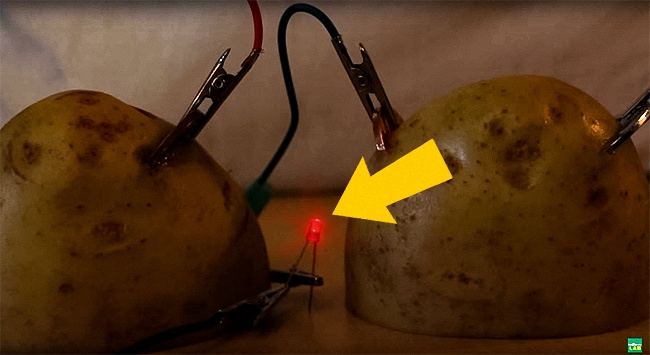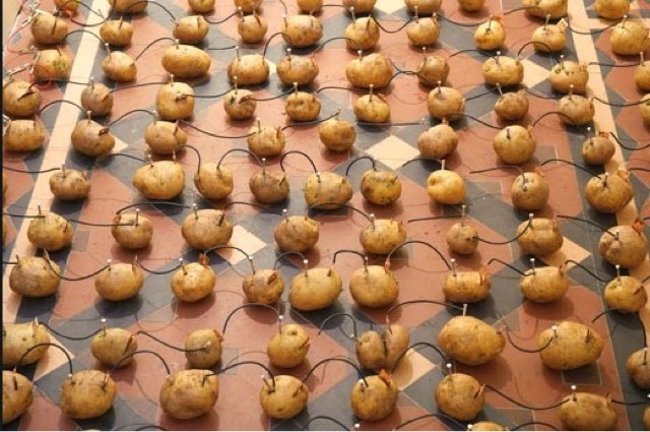Potato generator: A great experiment you can do at home with your baby
The study of electricity will become extremely interesting if you turn it into an experiment. Just use a potato, a few coins and two wires, you can create a small generator with enough electricity to light a light bulb.
Let's do the experiment to see: How this magic potato root really works!
You need to prepare:
- 2 potatoes
- 4 coins
- 4 zinc washers
- Electrical wire (preferably available clamp type)
- 1 light-emitting diode (LED)
 © HooplaKidzLab
© HooplaKidzLab
1. In this experiment, you can use 2 potatoes or just 1 bulb and cut them in half.
 © HooplaKidzLab
© HooplaKidzLab
2. Attach each coin to a single potato and a zinc wash ring.
 © HooplaKidzLab
© HooplaKidzLab
3. Use a wire to connect a coin from this potato to a cushion of other potato chips. Then, use a clip available at the power cord. If not, wrap around the wire that is not covered with a metal insulation cover.
 © HooplaKidzLab
© HooplaKidzLab
4. LED bulbs have 2 wires - positive and negative. Attach them to a wire.
5. Connect the remaining wire ends to the remaining coin and hammock.
6. Glowing lights!

If you want to increase the brightness of the bulb, you simply need to get more potatoes. The important thing is to connect the potato string in the right order: a potato from this potato will connect to a zinc ring of another potato and it will thus form a circle. Even a long string of potatoes can light an LED bulb.
 © labioguia.com
© labioguia.com
How do they work?
In potatoes containing salt and acid, it is a natural electrolyte. When you put up coins and zinc washers, the voltage can emit between them. If you connect a ten thousand designs in a potato, instead of an LED, you can see that the potato produces an electrical current of about 0.9 volts.
In order for an LED light bulb to work, you need a current of about 1.7 - 2 volts or 2-3 potatoes.
You should read it
- Science test: Potatoes can be grown on Mars
- The interesting history of potatoes: 'Devil's apple' brings prosperity to the empires
- To experience a night of 6 tons of 'potato' in the middle of the field, you have to spend 4.6 million
- Light bulbs all day without electricity from discarded plastic bottles
- How to make moon cakes of purple sweet potatoes for people who are afraid of fat
- Scientists generate electricity from the air by nanowires generated from bacteria
- You are curious, how the ancestors of today's vegetables are shaped
- 12 super foods you should have on the menu
May be interested
- Baby Three Drawing Collection with Step by Step Instructions
 baby three is a toy that is making young people crazy. if you don't have enough money to buy it, you can draw baby three yourself following the instructions below and decorate it on your favorite item.
baby three is a toy that is making young people crazy. if you don't have enough money to buy it, you can draw baby three yourself following the instructions below and decorate it on your favorite item. - How to generate QR codes with Me QR Generator on phones and computers
 the need to use qr codes for content to share these days has been very common. for example, create a qr code for a link on chrome browser, create a qr code on google sheets.
the need to use qr codes for content to share these days has been very common. for example, create a qr code for a link on chrome browser, create a qr code on google sheets. - How to Choose Between Windows 10 Home and Pro
 this article is part of a new format experiment! please don't tag. if you're shopping for a new pc, you've probably noticed two different versions of windows 10: home and pro. at first glance, they appear identical, as both share the same...
this article is part of a new format experiment! please don't tag. if you're shopping for a new pc, you've probably noticed two different versions of windows 10: home and pro. at first glance, they appear identical, as both share the same... - How to use AI Background Generator to create images based on keywords
 ai background generator creates images using keywords about a photo in your imagination and the results will surprise us.
ai background generator creates images using keywords about a photo in your imagination and the results will surprise us. - How to make a baby face on Snapchat
 snapchat baby filter photo effects will help you have a baby face, baby face when taking photos or recording videos.
snapchat baby filter photo effects will help you have a baby face, baby face when taking photos or recording videos. - Instructions for using Chrome's built-in password generator
 google chrome provides a password saving feature for all online accounts. chrome also has an integrated password generator, which automatically creates strong passwords with the click of a button.
google chrome provides a password saving feature for all online accounts. chrome also has an integrated password generator, which automatically creates strong passwords with the click of a button. - Bedroom decor template for handsome, scientific, stimulating creativity
 here are the bedroom designs for beautiful, scientific boys that can stimulate children's creative thinking.
here are the bedroom designs for beautiful, scientific boys that can stimulate children's creative thinking. - 10 ways to cook delicious shrimp porridge, nutritious baby food miles
 shrimp contains a lot of vitamins a, d, omega-3 and dha, the nutritional components are very good for health, helping children develop better physical and brain. therefore, shrimp is one of the food sources that should be supplemented for babies from weaning stage.
shrimp contains a lot of vitamins a, d, omega-3 and dha, the nutritional components are very good for health, helping children develop better physical and brain. therefore, shrimp is one of the food sources that should be supplemented for babies from weaning stage. - 6 Weird But Useful Things You Can Do With Your Smart TV
 using a smart tv to watch movies and tv shows is great, but many people also like to experiment, since it has built-in app support anyway.
using a smart tv to watch movies and tv shows is great, but many people also like to experiment, since it has built-in app support anyway. - How to play Baby Panda: Take care of animals, game of BabyBus
 with the game baby panda: care for animals, children will learn more about animals in appearance, care, food for animals ...
with the game baby panda: care for animals, children will learn more about animals in appearance, care, food for animals ...










 Gently 'water turns into ice' in a flash. Too simple
Gently 'water turns into ice' in a flash. Too simple Interesting scientific facts surprise you
Interesting scientific facts surprise you No need to be a singer, you can still smash a glass of water with singing
No need to be a singer, you can still smash a glass of water with singing How much is a thunderbolt worth?
How much is a thunderbolt worth? Why do you smash the glass bottle with your hand, the bottom part breaks?
Why do you smash the glass bottle with your hand, the bottom part breaks? See the world's largest pneumatic cannon cannon firing 'bullets' like a movie
See the world's largest pneumatic cannon cannon firing 'bullets' like a movie